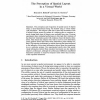Free Online Productivity Tools
i2Speak
i2Symbol
i2OCR
iTex2Img
iWeb2Print
iWeb2Shot
i2Type
iPdf2Split
iPdf2Merge
i2Bopomofo
i2Arabic
i2Style
i2Image
i2PDF
iLatex2Rtf
Sci2ools
91
Voted
BMCV
2000
Springer
2000
Springer
The Perception of Spatial Layout in a Virtual World
The perception and recognition of spatial layout of objects within a three-dimensional setting was studied using a virtual reality (VR) simulation. The subjects' task was to detect the movement of one of several objects across the surface of a tabletop after a retention interval during which time all objects were occluded from view. Previous experiments have contrasted performance in this task after rotations of the observers' observation point with rotations of just the objects themselves. They found that subjects who walk or move to new observation points perform better than those whose observation point remains constant. This superior performanceby mobile observers has been attributed to the influence of non-visual information derived from the proprioceptive or vestibular systems. Our experimental results show that purely visual information derived from simulated movement can also improve subjects' performance, although the performance differences manifested themselve...
BMCV 2000 | Computer Vision | Observation Point | Performanceby Mobile Observers | Retention Interval |
Related Content
| Added | 02 Aug 2010 |
| Updated | 02 Aug 2010 |
| Type | Conference |
| Year | 2000 |
| Where | BMCV |
| Authors | Heinrich H. Bülthoff, Chris Christou |
Comments (0)

